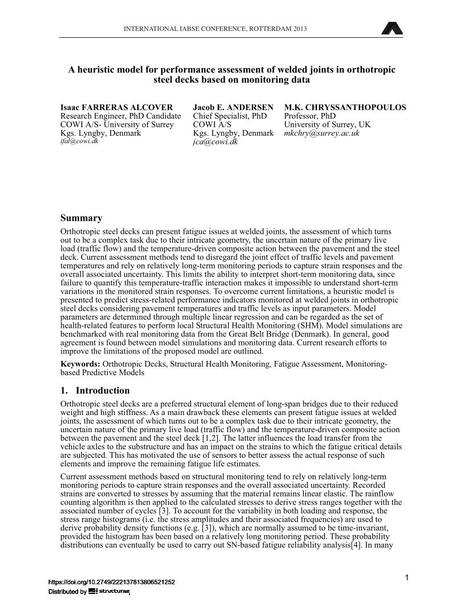A heuristic model for performance assessment of welded joints in orthotropic steel decks based on monitoring data

|
|
|||||||||||
Bibliographic Details
| Author(s): |
Isaac Farreras Alcover
Jacob E. Andersen M. K. Chryssanthopoulos |
||||
|---|---|---|---|---|---|
| Medium: | conference paper | ||||
| Language(s): | English | ||||
| Conference: | IABSE Conference: Assessment, Upgrading and Refurbishment of Infrastructures, Rotterdam, The Netherlands, 6-8 May 2013 | ||||
| Published in: | IABSE Conference, Rotterdam, May 2013 | ||||
|
|||||
| Page(s): | 512-513 | ||||
| Total no. of pages: | 8 | ||||
| Year: | 2013 | ||||
| DOI: | 10.2749/222137813806521252 | ||||
| Abstract: |
Orthotropic steel decks can present fatigue issues at welded joints, the assessment of which turns out to be a complex task due to their intricate geometry, the uncertain nature of the primary live load (traffic flow) and the temperature-driven composite action between the pavement and the steel deck. Current assessment methods tend to disregard the joint effect of traffic levels and pavement temperatures and rely on relatively long-term monitoring periods to capture strain responses and the overall associated uncertainty. This limits the ability to interpret short-term monitoring data, since failure to quantify this temperature-traffic interaction makes it impossible to understand short-term variations in the monitored strain responses. To overcome current limitations, a heuristic model is presented to predict stress-related performance indicators monitored at welded joints in orthotropic steel decks considering pavement temperatures and traffic levels as input parameters. Model parameters are determined through multiple linear regression and can be regarded as the set of health-related features to perform local Structural Health Monitoring (SHM). Model simulations are benchmarked with real monitoring data from the Great Belt Bridge (Denmark). In general, good agreement is found between model simulations and monitoring data. Current research efforts to improve the limitations of the proposed model are outlined. |
||||
| Keywords: |
orthotropic decks fatigue assessment structural health monitoring monitoring-based predictive model
|
||||
